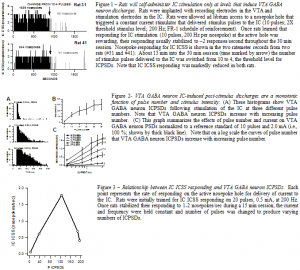Seth Gunderson and Dr. Scott Steffensen, Psychology
The basis for my project is predicated on the rewarding properties of alcohol and other substances of abuse. We set out to further our understanding the neural system that is involved in intracranial self stimulation (ICSS) and how this system is mediated by γ-aminobutyric acid (GABA) neurons. Studies involving intravenous self administration (SA) of opiates and psychostimulants have identified specific neural substrates that mediate the reinforcing actions of these drugs and they constitute part of the same central nervous reward system that has evolved for mediating natural motivated behaviors, the mesocorticolimbic dopamine (DA) system.1,2
The mesocortical limbic system has been implicated in habit forming actions of several rewarding drugs.3 Our lab has been investigating a unique phenomenon the arises with activation of the mesocortical limbic system through electrical activation of descending fibers that terminate in the ventral tegmental area (VTA) in the midbrain. Activation of these fibers produces excitatory neuronal activity which has been termed IC post-stimulus discharges (ICPSDs). It is thought that these discharges are implicated in self rewarding behavior. I sought to evaluate these discharges in a freely moving animal.
Animals were implanted with a bipolar stimulating electrode in the internal capsule. Approximately one fourth of the animals also received a carbon fiber recording electrode implanted in the VTA. The animals were placed in a sound attenuated chamber and were allowed free access to a nosepoke hole on both sides of the chamber. When the animal poked in the left hole an electrical stimulus was delivered through the electrode to the internal capsule. The stimulus intensity was the intensity that elicited ICPSDs during surgery.
During surgery we recorded the current and pulse thresholds that elicited ICPSDs in the VTA. It was noted that elicitation of ICPSD’s occurred at a given threshold for both current and pulse number. Below that threshold no ICPSDs were induced. We discovered that during a freely behaving session when the stimulus was dropped to a subthreshold level, the animal quit responding (Fig. 1). This is a novel finding with broad implications for drug addiction.
When we discovered that that the rate of ICSS of the internal capsule was related to the amount of current and pulse delivered we decided to see if there was a certain amount of current of pulses that would produce a maximum response. We soon found that it was difficult to alter the amount of current delivered too drastically because of descending motor fibers that run through the internal capsule as well. When activated by enough current these motor fibers cause a significant motor response in the animal which was usually a contraction or spasm on the animal’s right side of the body. We decided to instead alter the amount of pulses delivered while holding the current constant to see if there was maximum responding at a given pulse number. We evaluated the rate at which the animal responded versus the amount of ICPSDs which are directly related to the number of pulses delivered (Fig. 2). Even more compelling is our finding that the level of IC ICSS responding is an inverted U-shaped function, also characteristic of responding for cocaine SA, of VTA GABA neuron ICPSDs (Fig. 3), providing strong evidence that VTA GABA neuron electrical networks are involved in brain stimulation reward.
Although we were unable to investigate the effects of quinidine during ICSS (quinidine administration had a motor deficit that posed a problem to evaluating responding), we were able to better understand the role of GABA electrical networks in the VTA and their function in brain stimulation reward. There is more work to be done to further understand the exact role of GABA networks in the VTA. I hope to further pursue this work by investigating the exact role of GABA neurons during ICSS.
References
- Bloom, F.E., The Neurobiology of Addiction: An Integrative View, in Biological Basis of Substance Abuse, S.G. Korenman and J.D. Barchas, Editors. 1993, Oxford University Press: New York. p. 3-16.
- Koob, G.F., Dopamine, addiction and reward. Semin. Neurosci., 1992. 4: p. 139-148.
- Wise, R.A., Dopamine, learning and motivation. Nat Rev Neurosci, 2004. 5(6): p. 483-94.

